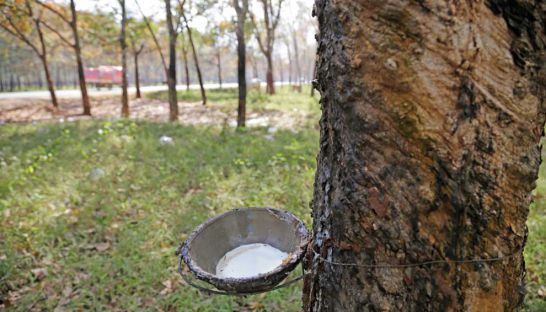Waiting to tap rubber’s rebound
Waiting to tap rubber’s rebound
The large-scale rubber plantations that arrived in force in Cambodia a decade ago as global rubber prices moved to historic peaks are facing sober prospects as trees they planted before the commodity’s prices headed south begin to reach maturity.

While international rubber prices have been slowly rising on a slight pick-up in demand from China, the world’s top consumer, a plantation owner said yesterday that the current $1,450 per tonne is not enough for large-scale producers to recoup their massive capital investment. He said that until rubber passes the $2,000 per tonne mark, it did not make economic sense to begin large-scale production.
Jef Boedt, general manager of Socfin Cambodia, the local arm of a Belgian-Swiss agro company with rubber plantations spread across Africa and Indonesia, said the first batch of rubber trees that the company has planted on 7,500 hectares in Cambodia since 2009 reached maturity earlier this year. However, this first tapping season has been limited, both at Socfin’s plantations in Mondulkiri province, and at others like it across the country.
“Right now, all the plantations that started planting six or seven years ago should be tappable today,” he said. “However, because the price and demand is not strong we are only tapping around 700 hectares when it should be around 1,500 to 2,000 hectares.”
He said limited tapping operations were yielding about 1.2 to 1.5 tonnes of rubber per hectare, whereas the standard business model is closer to 2 tonnes per hectare. So far, the company has produced around 1,000 tonnes of natural rubber this year, he added.
Boedt previously told the Post the company had invested $80 million into its Cambodia operations. Having waited seven years already to begin recouping this investment, its decision to press ahead with tapping aims at covering overheads, ensuring that workers are paid, and funding further infrastructure expansion.
But he said that large-scale producers were likely to wait until prices improve before scaling up their production.
“Because rubber plantations are a long-term investment, and take years to grow, investors need to be patient and wait for the prices to eventually rise,” he said.
“The goal for our company to start seeing major profits is [to wait until] prices reach $2,000 or $2,500 per tonne.”
Boedt added that he expects global rubber prices to begin rising sharply in 2018.He urged rubber plantation owners to hold on for long-term earnings from rubber, instead of cutting down trees and replacing them with other cash crops like cassava or pepper that can earn short-term gains.
Rising global rubber prices in the early 2000s fuelled a rush to scale-up production and cultivate new plantations. World rubber prices peaked in 2011 at $4,850 per tonne, before falling precipitously on a glut of supply and slower demand from China.
Pol Sopha, deputy director-general the rubber department at the Ministry of Agriculture, said that this year was already proving to be one of the best in recent times, and predicted that prices would continue to steadily increase.
“Prices continued to drop from 2011 until the end of 2015,” he said. “Now we are starting to see real increases.”
Sopha said the market price of rubber, which rose from $1,100 per tonne at the start of the year to $1,450 per tonne in September, had now reached $1,580 per tonne. This was a positive sign for producers, as the ministry’s calculations showed the breakeven point for large plantations was at somewhere between $1,350 and $1,450 per tonne.
He added that the Kingdom had planted rubber on around 400,000 hectares, with 130,000 hectares mature enough for cultivation.
“Cambodia still has a lot of potential for natural rubber cultivation and a lot of what has been planted is still not ready to be tapped,” Sopha said, adding that the country was primed for a future surplus of natural rubber.
Men Sopheak, vice president of the Cambodian Rubber Association, said that rubber prices had stabilised in recent months, and that small-scale rubber farmers were finally turning a profit.
“The current rubber price is allowing for small farmers to actually earn a profit, while larger plantations are deciding to just break even,” he said.
“Even if large plantations cannot make large profits yet, they are still tapping and producing in order to keep the company operational.”
While he projected that global trends could see rubber increase to $2,000 per tonne next year, he still believed that large-scale plantations would struggle to recoup the large capital costs associated with production, labour and domestically processing for export.
“However, these plantations are just waiting for when the price is better and then they can start to fully tap their trees,” he said, adding that a typical rubber tree, if managed properly, had a lifespan of 25 years. “Global prices don’t guarantee that rubber will make a profit all the time, but overall the potential is still there,” he added.













